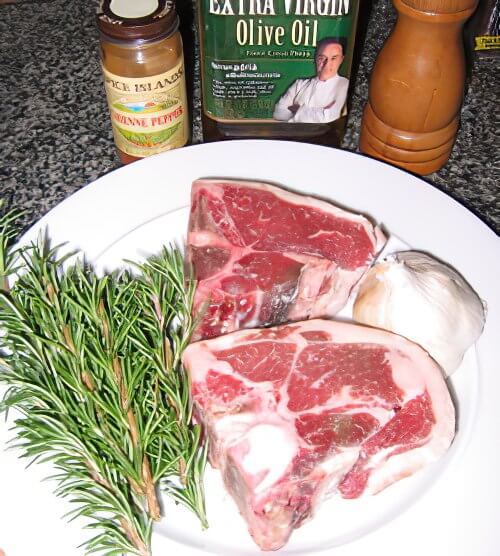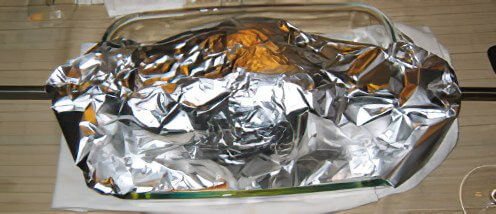Outdoor Grill Cooking is the most common form of outdoor cooking. Most people have some experience with grill cooking and even own a grill that is sitting out and rusting in their backyard. So here are some of the advantages to barbecue cooking. I’m pretty sure you’ll be convinced it’s a pretty special and fun way to prepare food. So get that grill out of storage, dust it off, and start grillin’!
There are several advantages to Outdoor Grill cooking
- The flavors! – Food cooked on a grill or barbecue is delicious! Why? The intense heat of the fire and the grill grate helps to caramelize the surface of your food. With this brown, golden color your food gets accents and brings out the flavors of your raw ingredients. Also, when cooking on a charcoal grill or on a gas grill with a wood smoker box the wood smoke flavors imparted to the food are great. Smoker woods like mesquite and hickory add distinct and unique aromas and flavors to compliment your food. There is no real way to recreate this indoors. Sure, you can use a few drops of liquid smoke, but its just not the same as cooking on an outdoor grill with all the real wood smoke.
- Convenience – Charcoal and gas grills are readily available and easy to use. You can find everything from simple inexpensive grills to gigantic fancy grills with cool features. Charcoal and gas are easy to find and buy.
- Versatility of fuels – There are several types of grills. Charcoal grills use wood charcoal for heat while gas grills use a gas source to supply the fire and heat. Charcoal is available in a variety of types, from processed charcoal to lump wood charcoal. Flavors can also be enhanced by the addition of smoking woods like mesquite and hickory. Nowadays most grills are made in natural gas grill versions (or can be converted to natural gas) allowing you to use your natural gas line in your home, burning cheaper, cleaner and never running out of fuel. Newest on the market are infrared burners available on many gas grills. These supply super-high intense heat for fast searing and sealing in those juices!
- Versatility of styles of barbecue cooking – Cooking on an outdoor grill doesn’t just mean trowing a burger on the grill anymore. From direct heat searing to indirect heat roast, from rotisserie cooking to smoker cooking, cooking on an outdoor grill is versatile. Find out more about styles of barbecue cooking.
- Versatility of recipes – Pretty much every cuisine the world round, every country, every style of cooking has recipes that can be, or should be, cooked on a grill or barbecue. From the simple to the elaborate and gourmet, there is an endless list of recipes for grill cooking.
So are there any disadvantages to Outdoor Grill cooking?
Well, I don’t think there are any, but here are a few that some people may complain about.
- Its messy – Sure, barbecue cooking is outdoors, but thats part of the fun! Also, getting the grill set up and dealing with that messy, sooty charcoal and later cleaning the grill is a bit of mess. I see it as part of the fun as well, but some people might find this to be a disadvantage.
- It takes time – If you are in a rush to get food ready, barbecue cooking might not be the best option for you. One solution to this is a gas or natural gas grill, which is easier to start up and turn off. Charcoal takes more time to get lit and get ready for cooking.
- Cooking with firewood – Most grills are not made to accommodate a real firewood fire. For the outdoor cooking purist this may be seen as a disadvantage. The real die-hard fire cooking lovers will tell you that there is nothing like cooking over real firewood embers. While I agree to some extent and love fire pit grilling too, this takes even more time than cooking on an outdoor grill with charcoal. Also, with real lump wood charcoal and or wood chips for smoking you can get very similar embers and flavors as a firewood fire. This really comes down to preference. I love both!
6 Types of Outdoor Grill Cooking
Which type of outdoor cooking does the Flame Gorilla© prefer? I use them all! It just depends on what I’m cooking and the mood I’m in.

The Charcoal Grill
This is the classic outdoor cooking grill. It is the gold standard for outdoor cooking for many grill lovers. It is versatile and easy to use.
Pros
- Simple – Charcoal is easy to find, relatively easy to light and you don’t need any other special accessories or fuel. You basically just start your coal fire and start cooking. Besides a wood fire grill, this is one of the most basic and traditional forms of outdoor cooking. While control of heat is not as easy as gas, a good charcoal grill has great control of temperature from low smoking temps to high searing heat. A wood fire is harder to control.
- Versatile – Despite its simplicity, a charcoal grill is versatile and can pretty much cook any type of outdoor cooking grilled foods. From direct heat searing to indirect heat roasts and even rotisserie and smoker cooking, charcoal can do it!
- Great Flavors – No doubt about it, a real hardwood fire with nice embers and charcoal supply the best wood smoke flavors to your food. While pressed charcoal briquets can have additives and “off” flavors, real lump hardwood charcoal gives just pure, natural wood flavors. You can also easily add chips or chunks of smoking woods to add particular flavors like mesquite, hickory, maple or others.
- Choice of Fuels – While basic pressed charcoal briquets are easy to find at any supermarket, there are a whole selection of other types of charcoal available. In particular, lump charcoal, made from real chunks of hardwood without any additives, supplies great heat from a natural source with great natural wood smoke flavors. They are available in many types and from many sources and are one of the best ways to improve your outdoor cooking.
- Inexpensive – In general, charcoal grills are less expensive than their gas or natural gas grill counterparts. While there are expensive ones out there, such as the awesome Big Green Egg, many of the best charcoal grills, such as the Weber kettle grills, can be found for very inexpensive.
Cons
- Messy – Yes, charcoal can get a bit messy, dirtying your hands and clothes. And it leaves a bunch of ash which you need to clean up before your next outdoor cooking grilling session.
- A Bit Slower to Start – While charcoal takes longer than a gas grill to get started and ready for cooking, with a little practice and a good charcoal starter like the charcoal chimney your charcoal can be hot and ready in minutes.

The Gas Grill
Another classic type of outdoor cooking that you see used very frequently. Many outdoor chefs love the speed, power, and ease of outdoor cooking on a good gas grill.
Pros
- Easy – No messy charcoal, no difficulty starting, a gas grill gets started up fast and easy, usually with the turn of a knob and the press of a button. No messy ash to clean up either.
- Features – Many gas grills have features available that aren’t seen on many charcoal grills. For example, many gas grills have optional side burners so that you can cook sauces, stews and soups on your grill while barbecuing the rest of your food.
- Natural Gas and Infrared Options – Nowadays natural gas is all the rage in outdoor cooking. Most gas grills either come in natural gas models or can be easily converted to natural gas if you want a clean and easily available source of fuel. Many new gas grills also have optional infrared burners which supply an intense heat source for high heat searing of foods.
Cons
- Lack of Wood Smoke – Gas grills in and of themselves do not create any wood smoke flavor to enhance your food. In fact, some people even feel that the gas gives some strange flavors to the food. The intense heat and grill grid do help create the nice caramelized golden surface on your grilled foods which adds flavor, but if wood smoke flavors are what you desire, the gas grill does not have it. The solution to this problem is getting a metal smoker box (included on many gas grills) which allows you to add lumps of smoking woods which give off rich smoke to flavor your outdoor cooking food. While this is not quite as good as a real wood fire, it does the job pretty well.
- Liquid Propane Tank Refilling – A propane gas grill requires occasional filling. When outdoor cooking, this can be a pain to lug around a big tank of propane and find a place to refill it. It is also an extreme pain if you run out of fuel in the middle of a party! Buy a back-up tank or check your tank regularly to make sure this doesn’t happen to you!
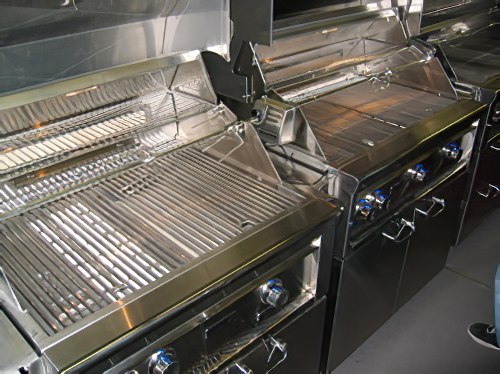
The Natural Gas Grill
Maybe you didn’t know this was an option. A natural gas grill means you’ll never run out of fuel in the middle of your outdoor cooking again!
Pros
- No Running Out of Fuel – A natural gas line (the same gas line that supplies your kitchen stovetop and oven) supplies constant, never-ending fuel to your natural gas grill (unless you forget to pay the gas bill!). No more heavy propane tanks or running out to refill. You are plugged in to a constant supply of fuel for your fire.
- Inexpensive Fuel – Compared to propane, natural gas is less expensive per BTU of heat supplied.
- Its More Green! – Natural gas burns cleaner than propane. Therefore it is theoretically better both for the environment as well as for your heath!
- All the Advantages of a Gas Grill – All the other advantages of a gas grill discussed above (easy and speed of use, infrared burners, side burners, etc.) apply to a natural gas grill as well.
Cons
- Lack of Wood Smoke – Just like a propane gas grill, in order to cook with wood smoke flavor, you’ll need to supply a smoker box with smoking wood chunks. Natural gas does not flavor your food on its own.
- Installation – These grills do require a natural gas line outlet near your grill and may require special installation. If you don’t have a line near your patio or backyard this may be costly and difficult.

The Smoker Grill
A specialty grill for slow-smoking foods for a unique and rich flavor.
Pros
- Wood Smoke Flavor – Smoked foods have an intense wood smoke aroma and flavor which is delicious and accompanies many foods beautifully. The most intense smoked flavors come from slow cooking on a closed smoker which literally baths your food in waves of rich wood smoke flavor.
- Long, Slow Roasting – Smoker grills are specifically designed for slow outdoor cooking at low temperatures. This allows you to slowly roast almost any cuts of meat, from small strips to whole roasts of poultry, over a long time, even hours, while slowly creating a rich smoke flavor throughout the meat. The result is succulent, savory roasts which are perfectly cooked through with rich smoke flavors.
Cons
- Not as Versatile – A dedicated smoker is specifically designed for slow smoking meats. Most are not as versatile for cooking other types of barbecue and grilled foods.
- Most Smoking Can Be Accomplished with a Good Gas or Charcoal Grill – You generally don’t need a dedicated smoker grill to make smoked foods. Either a gas or charcoal grill can be used at low indirect heat to slowly cook your food while using smoking wood chunks to supply the savory smoke.
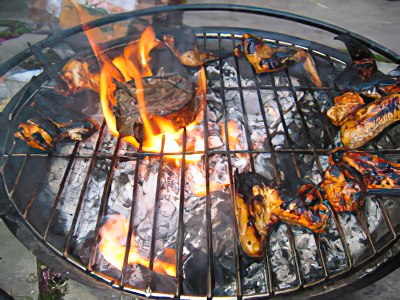
The Wood Grill or Fire Pit
Real firewood smoke flavor.
Pros
- Doubles as an Outdoor Fire Pit – A fire pit grill is basically a fire pit which has the ability to hold a grill grate over your wood fire or embers. This means that a wood grill can be used both as a fire pit, to sit around and enjoy the heat and ambiance, as well as a wood fire grill for cooking food over real wood embers.
- Firewood Cooking – This is one of the most basic and ancient forms of cooking. Cooking over a real hardwood fire or embers is the ultimate in natural wood smoke flavor.
- Large Size – Most fire pit grills are larger than your average charcoal grill allowing you to cook more food at the same time.
- Versatility – Cooking over a real wood fire allows you to both cook over high direct heat and to slowly roast foods. With a rotisserie apparatus you can slowly roast whole poultry or other roasts over your fire for even, thorough cooking.
- Skewer Cooking – Some smaller food items are ideally cooked on a skewer over an open fire. The classic example is roasting marshmallows and making s’mores. But other foods can be cooked on skewers (hot dogs, sausages, small game birds, etc.) allowing your guests to get in on the outdoor cooking!
Cons
- Longer Set Up – A real firewood fire takes longer than even charcoal to get started. Additionally, most grilled foods are best cooked over embers, not the initial flames. Therefore it takes longer to get the fire started and burn the wood down to a nice bed of embers to cook over. If you are in a rush then firewood outdoor cooking is maybe not for you.
- Availability of Firewood – Depending on where you live, good firewood for cooking may not be easily available year-round or may be expensive during parts of the year. If firewood is easily accessible to you, then cooking over a wood fire may be ideal. If it is expensive and hard to find, then you may have to settle for charcoal or gas.
- Intense Heat, Less Time – While wood embers supply an intense direct heat, they generally last shorter than charcoal (and certainly shorter than gas). Therefore you have to time your cooking just right and it may be hard to slow cook bigger roasts unless you have a rotisserie apparatus.

The Infrared Grill Burner
One of the newest technologies in outdoor cooking. Perfect seared foods every time!
Pros
- Intense Heat – An infrared grill burner directs the heat from a gas burner onto a ceramic tile which then converts the heat into infrared energy which radiates off the tile onto your food. This is a super intense source of heat which is capable of easily attaining very high temperatures which are hard to reach with charcoal or normal gas grills.
- Ideal for Searing – This high intense direct heat is ideal for searing cuts of meat quickly, locking in juices. You get a piece of meat which is nicely browned on the outside while staying succulent and juicy on the inside. Many chefs prefer these burners for cooking a perfect steak.
Cons
- Lack of Wood Smoke – Like a gas grill, these burners don’t supply any wood smoke flavors if that is what you desire. You cannot really add a smoker box directly to the infrared burner, so at most you may get a small amount of smoke for an adjacent smoker box on the gas grill the burner is on.
- Not as Versatile – These burners are really meant for high heat searing, cooking the outside and keeping the inside fresh and less cooked. This is ideal for a rare or medium-rare steak, but not so much so for a larger cut of meat or meat which must be cooked through completely. A chicken breast for example would probably be totally burnt on the outside before the inside was done. Some infrared grills have a wider range of temperature control, allowing you to cook more delicate meats like fish fillets or fish steaks, so make sure you look into the specific model you are buying.
Tips for Cooking on a Grill or Barbecue
Cooking on a grill is fun and a great way to enjoy the outdoors while making some delicious food. Most of us have cooked basic burgers or hot dogs but grill cooking is versatile and there are many ways to cook on a barbecue. I thought it would be good to cover some basics of barbecue cooking that may not be obvious to all of those who are beginners to outdoor grilling or who haven’t yet gotten creative with their grill cooking.
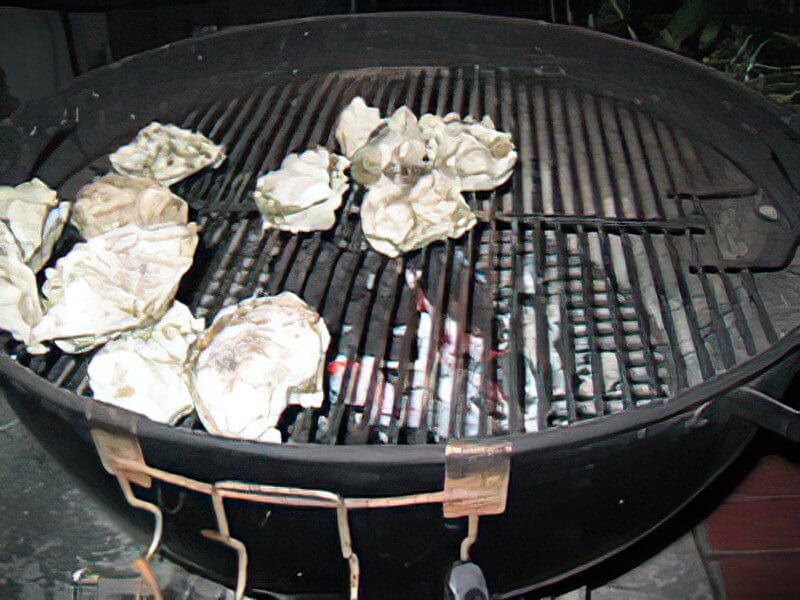
Here are a few basic tips to make your cooking on a grill easier and the foods you grill better.
- Appropriate utensils – The cheapskate in each of us may think we can get along cooking on a grill with using just any utensils on the grill. I myself have tried turning steaks or burgers with a regular fork or knife. And I have singed off my arm hair to show for it! Don’t sell yourself or your cooking on a grill short! The proper utensils will make cooking easier and will even be safer, preventing burns. They can also ensure that your foods are turned and handled properly. It would be a shame to drop your prime dry aged steak on the floor because you don’t have the proper utensils!
So what do you need? At least a barbecue fork, spatula, basting brush and tongs. You can get away with less but it is nice to have them all.
Tongs – If I had to choose one, it would probably be the tongs. They are the most versatile and effective for adding food to the grill, turning food and removing food.
Spatula – The spatula can be particularly effective for lifting and flipping foods which are flatter and more delicate. For example, grilled fish does not do well with a tongs, they often tear the delicate flesh and it falls apart. Burger patties, because they are made from ground meat, also can fall apart if handled too roughly and a spatula is ideal to scoop it up and flip it.
Fork – A fork can help to skewer items to move them or turn them but is also great for piercing meat to observe the fluid that runs from the holes. A chicken or pork cut which is done will run clear, without any pink or red in the liquid.
Basting Brush – Finally, a basting brush is required to baste your meat while it is cooking on a grill. Don’t try doing it with a short kitchen brush, you’ll burn your hands! Get a nice long barbecue basting brush.
Marinating and Basting – Cooking on a grill is cooking with dry heat. The hot air, radiant heat and hot smoke can all dry out your food.
Marinating – Marinating meats before cooking on a grill helps to add flavor and juices to your meat. It can take a bland piece of meat and turn it into a rich, flavorful meal. Generally, foods that are leaner and have less inherent fat in the meat will require marinating. Very fatty cuts like prime beef rib eye, porterhouse or New York cuts have “marbling”, strips of fat running through the meat. This melts as it cooks, infusing your food with rich flavor and juices. Lean cuts can dry out though because they don’t have this built-in flavor and juice machine! Chicken and turkey breast, pork chops and pork loin, and veal are all very lean and have less inherent flavor. These really benefit from marinating. There are many options for marinating, from dressings to wine and herbs, garlic, olive oil, mustard and many other flavor adding ingredients. For some meats that are very prone to drying out, like larger cuts of pork and turkey breasts, brining is an option to help seal in flavors and kept the meat tender, juicy and succulent.
Basting – While cooking on a grill, whether you marinated or not, basting helps to keep your food moist and adds flavor to the surface. As the basting fluid on the surface cooks, it helps form a rich, golden glaze on your food which caramelizes and adds tremendous smokey flavors. Generally, start basting, with a basting brush, a while after the meat has been cooking and repeat periodically as the surface browns and gets caramelized. Basting can be done with simple olive oil but also benefits from other sauces and marinades. You can use the drippings from your marinade to baste, but remember that it touched your raw food so allow ample time or the surface to cook after basting for the last time. Basting with richer sauces with a high sugar content should be reserved for the last several minutes of cooking. Sauces like barbecue sauce and teriyaki sauce can burn and get too caramelized if left over high heat too long. Rather, start the meat without the sauce and baste with the sauce only for the last 10 minutes or so of cooking, giving it time to thicken and caramelize, but not burn.
- Charcoal – Cooking on a grill with charcoal is a great way to add great, aromatic, smokey flavors to your food. While basic pressed, processed charcoal (like Kingsford briquets) are widely available, I recommend finding some real hardwood lump charcoal. It is without chemicals and is made from whole chunks of real hardwood firewood. Therefore, its flavors are better and it has no chemical additives.
Starting your charcoal can also be tricky for the beginner cooking on a grill. Make it easier for yourself by learning the different types of charcoal starter. My personal favorite is the charcoal chimney which makes starting any charcoal easy, fast and chemical free!
Flavoring with Smoking Woods – You can get even more distinct, smokey flavor into your grilled foods with smoking woods. A gas grill has no smoke flavor and therefore needs smoking woods (in a metal smoker box) to add this type of barbecue flavor. You can also use wood chips or chunks in a charcoal grill, throwing the woods right on your hot coals. How do you do it? Soak your smoking wood (mesquite and hickory are the two most common types you’ll see, both widely available as chips or chunks) in water for about half an hour before barbecue cooking on a grill. Drain and simply spread your wood on your hot coals (or put them in a smoker box and put it in your gas grill). As they heat, in about 10 to 15 minutes, they will start to smoke, giving off a savory rich smokey aroma and flavor. Be sure to close your grill lid to let the smoke swirl around and envelope your food, infusing it with flavor. If your smoking wood chunks catch fire, you probably didn’t soak them in water long enough.
Let Your Meat Rest! – This is an often overlooked part to cooking on a grill. In fact, it applies to any larger cuts of meat no matter how you cook it, stove or grill. After finishing cooking, remove your meat and place on a platter. Cover loosely with aluminum foil and set in a warm place to rest. This lets the heat and juices redistribute. They are in a state of flux while cooking over the high heat of a grill, so you want them to calm down and distribute themselves evenly throughout the meat. How long you rest your meat depends on the size of the roast but it should be done for at least 5 to 10 minutes, much longer for larger cuts of meat like a whole leg of lamb, chicken or turkey. These can withstand 30 minutes of resting and will not be harmed by even longer. Remember that the interior of your meat will continue to cook a bit as it sits (especially for the larger roasts) so you can take them off the grill when they are just shy of being perfectly done.
Hi, I’m Adam and I’m a HUGE fan of Food and Cooking.
Do you enjoy grilling sessions with your family while staring at the beautiful fire pit flames?
Flame Gorilla is the site to learn how to have that perfect backyard experience.


